Vegetation Fires in the Lubumbashi Charcoal Production Basin (The Democratic Republic of the Congo): Drivers, Extent and Spatiotemporal Dynamics
Abstract
:1. Introduction
2. Materials and Methods
2.1. Biophysical Description of the Study Area
2.2. Methods
2.2.1. Data
2.2.2. Preprocessing of Landsat Images
2.2.3. Landsat Image Classification and Validation
2.3. Analysis of Vegetation Fires in the LCPB
2.3.1. Distribution and Destructive Power
2.3.2. Quantifying the Spatiotemporal Dynamics of Burnt Areas and Assessing Their Impact
2.3.3. Determination of the Impact of the Road Network and Dwellings on the Spread of Fires in the LCPB
3. Results
3.1. Analysis of the Distribution of Fires and the Destructive Power of Fires in the Study Area between 2002 and 2022
3.2. Spatiotemporal Dynamics of Bushfires in the LCPB: Quantification of the Number of Fires and the Area Burnt in Land Occupations
3.3. Impact of Roads and Dwellings on the Spread of Fires in the LCPB
4. Discussion
4.1. Methodology
4.2. Characterization of Bushfire Dynamics and Their Impact on Miombo in the LCPB Region
4.3. Implications for Combating Wildfire and Preserving the Biodiversity of the Miombo in the LCPB
5. Conclusions
Author Contributions
Funding
Data Availability Statement
Conflicts of Interest
References
- Harris, N.L.; Gibbs, D.A.; Baccini, A.; Birdsey, R.A.; de Bruin, S.; Farina, M.; Fatoyinbo, L.; Hansen, M.C.; Herold, M.; Houghton, R.A.; et al. Global maps of twenty-first century forest carbon fluxes. Nat. Clim. Chang. 2021, 11, 234–240. [Google Scholar] [CrossRef]
- Friedlingstein, P.; O’sullivan, M.; Jones, M.W.; Andrew, R.M.; Hauck, J.; Olsen, A.; Peters, G.P.; Peters, W.; Pongratz, J.; Sitch, S.; et al. Global carbon budget 2020. Earth Syst. Sci. Data Discuss. 2020, 4, 1–3. [Google Scholar] [CrossRef]
- Baccini, A.; Walker, W.; Carvalho, L.; Farina, M.; Sulla-Menashe, D.; Houghton, R.A. Tropical forests are a net carbon source based on aboveground measurements of gain and loss. Science 2017, 358, 230–234. [Google Scholar] [CrossRef] [PubMed]
- Defourny, J.-P.; Delhage, C.; Kibambe, L.J.-P. Analyse Quantitative des Causes de la Déforestation et de la Dégradation des Forêts en République Démocratique du Congo; Rapport Final; FAO: Kinshasa, Democratic Republic of the Congo, 2011. [Google Scholar]
- Gillet, P.; Vermeulen, C.; Feintrenie, L.; Dessart, H. Quelles sont les causes de la déforestation dans le bassin du Congo? Synthèse bibliographique et étude des cas. Biotechnol. Agron. Société Environ. 2016, 20, 183–194. [Google Scholar] [CrossRef]
- Seaman, D.J.I.; Voigt, M.; Bocedi, G.; Travis, J.M.J.; Palmer, S.C.F.; Ancrenaz, M.; Wich, S.; Meijaard, E.; Bernard, H.; Deere, N.J.; et al. Orangutan movement and population dynamics across human-modified landscapes: Implications of policy and management. Landsc. Ecol. 2021, 36, 2957–2975. [Google Scholar] [CrossRef]
- Bauer, H.; Packer, C.; Funston, P.F.; Henschel, P.; Nowell, K. Panthera Leo (Errata Version Published in 2017). The IUCN Red List of Threatened Species 2016: E.T15951A115130419. Available online: https://www.iucnredlist.org/species/15951/231696234 (accessed on 17 September 2023). [CrossRef]
- FAO. Global Forest Resources Assessment. 2020. Available online: https://www.fao.org/forest-resources-assessment/2020/en/ (accessed on 14 July 2023).
- Agbeshie, A.A.; Abugre, S.; Atta-Darkwa, T.; Awuah, R. A review of the effects of forest fire on soil properties. J. For. Res. 2022, 33, 1419–1441. [Google Scholar] [CrossRef]
- Eba’a Atyi, R.; Hiol Hiol, F.; Lescuyer, G.; Mayaux, P.; Defourny, P.; Bayol, N.; Nasi, R. Les Forêts du Bassin du Congo: État des Forêts; CIFOR: Bogor, Indonesia, 2021. [Google Scholar]
- Curtis, P.G.; Slay, C.M.; Harris, N.L.; Tyukavina, A.; Hansen, M.C. Classifying drivers of global forest loss. Science 2018, 361, 1108–1111. [Google Scholar] [CrossRef]
- Hansen, M.C.; Potapov, P.V.; Moore, R.; Hancher, M.; Turubanova, S.A.; Tyukavina, A.; Thau, D.; Stehman, S.V.; Goetz, S.J.; Loveland, T.R.; et al. High-resolution global maps of 21st-century forest cover change. Science 2013, 342, 850–853. [Google Scholar] [CrossRef]
- Böhrkircher, L.; Leuchner, M.; Bayro Kaiser, F.; Reicher, C. Problems of Deforestation and Its Drivers. In Priority-Zone Mapping for Reforestation; SpringerBriefs in Geography; Springer: Cham, Switzerland, 2023. [Google Scholar] [CrossRef]
- Bowman, D.M.J.S.; O’Brien, J.A.; Goldammer, J.G. Pyrogeography and the global quest for sustainable fire management. Annu. Rev. Environ. Resour. 2013, 38, 57–80. [Google Scholar] [CrossRef]
- Krebs, P.; Pezzatti, G.B.; Mazzoleni, S.; Talbot, L.M.; Conedera, M. Fire regime: History and definition of a key concept in disturbance ecology. Theory Biosci. 2010, 129, 53–69. [Google Scholar] [CrossRef]
- Stone, G.D. Keeping the home fires burning: The changed nature of householding in the Kofyar homeland. Hum. Ecol. 1998, 26, 239–265. [Google Scholar] [CrossRef]
- Forman, R.T.T. Horizontal processes, roads, suburbs. societal objectives, and landscape ecology. In Landscape Ecological Analysis: ISSUES and Applications; Klopatek, J.M., Gardner, R.H., Eds.; Springer: New York, NY, USA, 1999; pp. 35–53. [Google Scholar]
- Kana, C.E.; Etouna, J.E. Apport de Trois Méthodes de Détection des Surfaces Brûlées par Imagerie Landsat ETM+: Application au Contact Forêt-Savane du Cameroun. Cybergeo 2006. [Google Scholar] [CrossRef]
- Eva, H.; Grégoire, J.M.; Mayaux, P.; Chevallier, D. Suivi des Feux de Végétation Dans les Aires Protégées d’Afrique Sub-Saharienne; European Commission: Brussels, Belgium, 2003. [Google Scholar] [CrossRef]
- Tyukavina, A.; Hansen, M.C.; Potapov, P.V.; Stehman, S.V.; Smith-Rodriguez, K.; Okpa, C.; Aguilar, R. Types and rates of forest disturbance in Brazilian Legal Amazon, 2000–2013. Sci. Adv. 2017, 3, e1601047. [Google Scholar] [CrossRef] [PubMed]
- Hislop, S.; Haywood, A.; Jones, S.; Soto-Berelov, M.; Skidmore, A.; Nguyen, T.H. A satellite data driven approach to monitoring and reporting fire disturbance and recovery across boreal and temperate forests. Int. J. Appl. Earth Obs. Geoinf. 2020, 87, 102034. [Google Scholar] [CrossRef]
- Vancutsem, C.; Achard, F.; Pekel, J.F.; Vieilledent, G.; Carboni, S.; Simonetti, D.; Nasi, R. Long-term (1990–2019) monitoring of forest cover changes in the humid tropics. Sci. Adv. 2021, 7, eabe1603. [Google Scholar] [CrossRef]
- Potapov, P.V.; Turubanova, S.A.; Hansen, M.C.; Adusei, B.; Broich, M.; Altstt, A.; Mane, L.; Justice, C.O. Quantifyng forest cover loss in Democratic Republic of the Congo, 2000–2010, with Landsat ETM+data. Remote Sens. Environ. 2012, 122, 106–116. [Google Scholar] [CrossRef]
- Global Forest Watch. Available online: https://www.globalforestwatch.org/dashboards/country/COD/?category=forestchange&location=WyJjb3VudHJ5IiwiQ09EIl0%3D (accessed on 9 December 2023).
- Mwitwa, J.; German, L.; Muimba-Kankolongo, A.; Puntodewo, A. Governance and sustainability challenges in landscapes shaped by mining: Mining forestry linkages and impacts in the Copper Belt of Zambia and the DR Congo. For. Policy Econ. 2012, 25, 19–30. [Google Scholar] [CrossRef]
- Useni Sikuzani, Y.; Boisson, S.; Cabala Kaleba, S.; Nkuku Khonde, C.; Malaisse, F.; Halleux, J.M.; Munyemba Kankumbi, F. Dynamique de l’occupation du sol autour des sites miniers le long du gradient urbain-rural de la ville de Lubumbashi, RD Congo. Biotechnol. Agron. Société Environ. 2020, 24, 14–27. [Google Scholar] [CrossRef]
- Brown, C.; Boyd, D.S.; Kara, S. Landscape Analysis of Cobalt Mining Activities from 2009 to 2021 Using Very High Resolution Satellite Data (Democratic Republic of the Congo). Sustainability 2022, 14, 9545. [Google Scholar] [CrossRef]
- Cabala, K.S.; Useni, S.Y.; Sambieni, K.R.; Bogaert, J.; Munyemba, K.F. Dynamique des écosystèmes forestiers de l’Arc Cuprifère Katangais en République Démocratique du Congo. Causes, Transformations spatiales et ampleur. Tropicultura 2017, 35, 192–202. [Google Scholar]
- White, F. La Végétation de L’afrique: Mémoire Accompagné de la Carte de la Végétation de l’Afrique; ORSTOM-UNESCO: Paris, France, 1983; 384p. [Google Scholar]
- Malaisse, F. How to Live and Survive in Zambezian Open Forest (Miombo Ecoregion); Presses Agronomiques de Gembloux: Gembloux, Belgium, 2010. [Google Scholar]
- Campbell, B.M.; Angelsen, A.; Cunningham, A.; Katerere, Y.; Sitoe, A.; Wunder, S. Miombo Woodlands–Opportunities and Barriers to Sustainable Forest Management; CIFOR: Bogor, Indonesia, 2007; p. 41. [Google Scholar]
- Muteya, H.K.; Nghonda, D.-d.N.; Kalenda, F.M.; Strammer, H.; Kankumbi, F.M.; Malaisse, F.; Bastin, J.-F.; Sikuzani, Y.U.; Bogaert, J. Mapping and Quantification of Miombo Deforestation in the Lubumbashi Charcoal Production Basin (DR Congo): Spatial Extent and Changes between 1990 and 2022. Land 2023, 12, 1852. [Google Scholar] [CrossRef]
- Johnson, L.; Smith, A.; Brown, P. Influences of Anthropogenic Activities on Landscape Dynamics in the Miombo Woodlands. J. Environ. Manag. 2020, 265, 110569. [Google Scholar]
- Sikuzani, Y.U.; Mukenza, M.M.; Malaisse, F.; Kaseya, P.K.; Bogaert, J. The Spatiotemporal Changing Dynamics of Miombo Deforestation and Illegal Human Activities for Forest Fire in Kundelungu National Park, Democratic Republic of the Congo. Fire 2023, 6, 174. [Google Scholar] [CrossRef]
- Kabulu, D.J.-P.; Vranken, I.; Bastin, J.-F.; Malaisse, F.; Nyembwe, N.S.; Useni, S.Y.; Ngongo, L.M.; Bogaert, J. Approvisionnement En Charbon de Bois Des Ménages Lushois: Quantités, Alternatives et Conséquences. In Anthropisation des Paysages Katangais; Bogaert, J., Colinet, G., Mahy, G., Eds.; Presses Universitaires de Liège: Liège, Belgique, 2018; pp. 297–311. [Google Scholar]
- Bogaert, J.; Barima, Y.S.S.; Ji, J.; Jiang, H.; Bamba, I.; Iyongo, W.M.L.; Mama, A.; Nyssen, E.; Dahdouh-Guebas, F.; Koedam, N. A methodological framework to quantify anthropogenic effects on landscape pattern. In Landscape Ecology in Asian Cultures; Hong, S.-K., Wu, J., Kim, J.-E., Nakagoshi, N., Eds.; Part 2; Springer: New York, NY, USA, 2011; pp. 141–167. [Google Scholar]
- Devineau, J.L.; Fournier, A.; Nignan, S. Savanna fire regimes assessment with MODIS fire data: Their relationship to land cover and plant species distribution in western Burkina Faso (West Africa). J. Arid. Environ. 2010, 74, 1092–1101. [Google Scholar] [CrossRef]
- Giglio, L.; Descloitres, J.; Justice, C.O.; Kaufma, Y. An enhanced contextual fire detection algorithm for MODIS. Remote Sens. Environ. 2003, 87, 273–282. [Google Scholar] [CrossRef]
- Lemenkova, P.; Debeir, O. R Libraries for Remote Sensing Data Classification by K-Means Clustering and NDVI Computation in Congo River Basin, DRC. Appl. Sci. 2022, 12, 12554. [Google Scholar] [CrossRef]
- Bogaert, J.; André, M. L’écologie du paysage: Une discipline unificatrice. Tropicultura 2013, 31, 1–2. [Google Scholar]
- Saley, A. Utilisation des Nouvelles Techniques de Cartographie Pour L’étude de la Dynamique de L’occupation du Sol Dans la Commune Rurale de Namaro; CRESA: Niamey, Niger, 2006; 82p. [Google Scholar]
- Koua, K.A.N.; Bamba, I.; Barima, Y.S.S.; Kouakou, A.T.M.; Kouakou, K.A.; Sangne, Y.C. Echelle spatiale et dynamique de la forêt classée du Haut-Sassandra (Centre-Ouest de la Côte d’Ivoire) en période de conflits. Rev. Environ. Biodiversité-PASRES 2017, 2, 54–68. [Google Scholar]
- Mama, A.; Sinsin, B.; De Cannière, C.; Bogaert, J. Anthropisation et dynamique des paysages en zone soudanienne au nord du Bénin. Tropicultura 2013, 31, 78–88. [Google Scholar]
- Kottek, M.; Grieser, J.; Beck, C.; Rudolf, B.; Rubel, F. World Map of the Köppen-Geiger Climate Classification Updated. Meteorol. Z. 2006, 15, 259–263. [Google Scholar] [CrossRef]
- Assani, A.A. Analyse de la variabilité temporelle des précipitations (1916–1996) à Lubumbashi (Congo-Kinshasa) en relation avec certains indicateurs de la circulation atmosphériques (oscillation australe) et océanique (El Nino/La Nina). Sécheresse 1999, 10, 245–252. [Google Scholar]
- Leblanc, M.; Malaisse, F. Lubumbashi, un Ecosystème Urbain Tropical; Centre International de Sémiologie, Université Nationale du Zaïre: Lubumbashi, Democratic Republic of the Congo, 1978. [Google Scholar]
- Baert, G.; van Ranst, E.; Ngongo, M.L.; Kasongo, E.L.; Verdoodt, A.; Mujinya, B.B.; Mukalay, J.M. Guide des Sols en République Démocratique du Congo, Tome II: Description et Données Physico-Chimiques de Profils Types; Ecole Technique Salama-Don Bosco: Lubumbashi, Democratic Republic of the Congo, 2009; ISBN 978-90-76769-98-1. [Google Scholar]
- Cabala, K.S.; Useni, S.Y.; Munyemba, K.F.; Bogaert, J. Activités Anthropiques et Dynamique Spatiotemporelle de La Forêt Claire Dans La Plaine de Lubumbashi. In Anthropisation des Paysages Katangais; Bogaert, J., Colinet, G., Mahy, G., Eds.; Presses Universitaires de Liège: Liège, Belgique, 2018; pp. 253–266. [Google Scholar]
- Mukenza, M.M.; Muteya, H.K.; Nghonda, D.-D.N.; Sambiéni, K.R.; Malaisse, F.; Kaleba, S.C.; Bogaert, J.; Sikuzani, Y.U. Uncontrolled Exploitation of Pterocarpus tinctorius Welw. And Associated Landscape Dynamics in the Kasenga Territory: Case of the Rural Area of Kasomeno (DR Congo). Land 2022, 11, 1541. [Google Scholar] [CrossRef]
- Dibwe, M.D. Lubumbashi, Ville Industrielle Attractive et Repulsive (1910–2008); Los Restos de la Pobreza Urbana: Madrid, Spain, 2009. [Google Scholar]
- Gorelick, N.; Hancher, M.; Dixon, M.; Ilyushchenko, S.; Thau, D.; Moore, R. Google Earth Engine: Planetary-Scale Geospatial Analysis for Everyone. Remote Sens. Environ. 2017, 202, 18–27. [Google Scholar] [CrossRef]
- Palumbo, I.; Grégoire, J.-M.; Simonetti, D.; Punga, M. Spatio-temporal distribution of fire activity in protected areas of SubSaharan Africa derived from MODIS data. Procedia Environ. Sci. 2011, 7, 26–31. [Google Scholar] [CrossRef]
- Nkwunonwo, U.C. Land use/Land cover mapping of the Lagos Metropolis of Nigeria using 2012 SLC-off Landsat ETM+ Satellite Images. Int. J. Sci. Eng. Res. 2013, 4, 1217–1223. [Google Scholar]
- Barima, Y.S.S.; Barbier, N.; Bamba, I.; Traore, D.; Lejoly, J.; Bogaert, J. Dynamique paysagère en milieu de transition ivoirienne. Bois Trop. 2009, 299, 15–25. [Google Scholar] [CrossRef]
- Phan, T.N.; Kuch, V.; Lehnert, L.W. Land Cover Classification Using Google Earth Engine and Random Forest Classifier—The Role of Image Composition. Remote Sens. 2020, 12, 2411. [Google Scholar] [CrossRef]
- Breiman, L. Random Forests. Mach. Learn. 2001, 45, 5–32. [Google Scholar] [CrossRef]
- Olofsson, P.; Foody, G.M.; Herold, M.; Stehman, S.V.; Woodcock, C.E.; Wulder, M.A. Good Practices for Estimating Area and Assessing Accuracy of Land Change. Remote Sens. Environ. 2014, 148, 42–57. [Google Scholar] [CrossRef]
- Giglio, L.; van der Werf, G.R.; Randerson, J.T.; Collatz, G.J.; Kasibhatla, P. Estimation of burned area using MODIS active fire observations. Atmos. Chem. Phys. 2006, 6, 957–974. [Google Scholar] [CrossRef]
- Diggle, P. A Kernel method for smoothing point process data. Appl. Stat. 1985, 34, 138. [Google Scholar] [CrossRef]
- Müller, D.; Suess, S. Can the MODIS active fire hotspots be used to monitor vegetation fires in the Lao PDR. In Deutsche Gesellschaft für Internationale Zusammenarbeit (GIZ) Climate Protection through Avoided Deforestation (CliPAD) Programme; Deutsche Gesellschaft für Internationale Zusammenarbeit (GIZ): Bonn, Germany, 2011; 50p. [Google Scholar]
- Boschetti, L.; Roy, D.; Hoffmann, A.A.; Humber, M. MODIS Collection 5 Burned Area Product-MCD45. User’s Guide Ver. 2009, 2, 1–2. [Google Scholar]
- Dahan, K.S.; N’da, H.D.; Kaudjhis, C.A. Dynamique spatiotemporelle des feux de 2001 à 2019 et dégradation du couvert végétalen zone de contact forêt-savane, Département de Toumodi, Centre de la Côte d’Ivoire. Afr. Sci. 2021, 19, 94–113. [Google Scholar]
- Fornacca, D.; Ren, G.; Xiao, W. Performance of three MODIS fire products (MCD45A1, MCD64A1, MCD14ML), and ESA Fire_CCI in a mountainous area of Northwest Yunnan, China, characterized by frequent small fires. Remote Sens. 2017, 9, 1131. [Google Scholar] [CrossRef]
- N’tambwe Nghonda, D.-d.; Muteya, H.K.; Kashiki, B.K.W.N.; Sambiéni, K.R.; Malaisse, F.; Sikuzani, Y.U.; Kalenga, W.M.; Bogaert, J. Towards an Inclusive Approach to Forest Management: Highlight of the Perception and Participation of Local Communities in the Management of miombo Woodlands around Lubumbashi (Haut-Katanga, D.R. Congo). Forests 2023, 14, 687. [Google Scholar] [CrossRef]
- Bamba, I.; Yedmel, M.S.; Bogaert, J. Effets des routes et des villes sur la forêt dense dans la province orientale de la République Démocratique du Congo. Eur. J. Sci. Res. 2010, 43, 417–429. [Google Scholar]
- Caillault, S.; Ballouche, A.; Delahaye, D. Organisation spatio-temporelle des feux de brousse. Approche comparative au Burkina Faso. In Proceedings of the Actes des Neuvièmes Rencontres de Théo Quant, Besançon, France, 9 March 2010. [Google Scholar]
- Giglio, L.; Schroeder, W.; Hall, J.; Justice, C. MODIS Collection 6 Active Fire Product User’s Guide Revision, B. NASA. 2018. Available online: https://www.earthdata.nasa.gov/s3fspublic/imported/MODIS_C6_Fire_User_Guide_B.pdf (accessed on 25 July 2023).
- Cizungu, N.C.; Tshibasu, E.; Lutete, E.; Mushagalusa, C.A.; Mugumaarhahama, Y.; Ganza, D.; Bogaert, J. Fire risk assessment, spatiotemporal clustering and hotspot analysis in the Luki biosphere reserve region, western DR Congo. Trees For. People 2021, 5, 100104. [Google Scholar] [CrossRef]
- Fusco, J. Analyse des Dynamiques Spatio-Temporelles des Systèmes de Peuplement Dans un Contexte D’incertitude. Application à L’archéologie Spatiale. Ph.D. Thesis, UMR 7300 ESPACE (Université Nice Sophia-Antipolis), Nice, France, 2016. [Google Scholar]
- Ricotta, C.; Bajocco, S.; Guglietta, D.; Conodera, M. Assensing the influence of roads on five inition: Does land cover matter? Fire 2018, 1, 24. [Google Scholar] [CrossRef]
- Gueguim, C.D.; Tchamba, N.M.; Fotso, C.R. Dynamique spatio-temporelle des feux de brousse dans le Parc National du Mbam et Djerem (Cameroun). Int. J. Biol. Chem. Sci. 2018, 12, 728–748. [Google Scholar] [CrossRef]
- Guiot, J.; Mazurek, H.; Curt, T.; Raimbault, P.; Collange, L.; Thomas, S. Marseille et L’environnement: Bilan, Qualité et Enjeux: Le Développement Durable D’une Grande Ville Littorale Face au Changement Climatique; Presses Universitaires de Provence: Aix en Provence, France, 2021. [Google Scholar]
- Mouillot, F.; Dupuy, J.L.; Barbero, R. Feux de Végétation: Comprendre Leur Diversité et Leur Evolution; Quae: Versailles, France, 2022; pp. 1–136. [Google Scholar]
- Colin, P.Y.; Marielle, J.; Mariel, A. La Prévention: Éviter Tout Départ de Feu, Protection des Forêts Contre L’incendie, Cahier FAO Conservation n 36; Inrae: Provence-Alpes-Côte, France, 2001; pp. 61–66. [Google Scholar]
- Lutete, E.L.; Lubini, C.; Kibambe, L.; Ngomba, M.N.; Luya, Y.W.; Lumbuenamo, R.S. Impacts of bush fires on biodiversity of Sudanian and Zambezian savanna of the Democratic Republic of Congo–case study on three protected areas: Upemba, Kundelungu and Garamba National Parks, and Bombo-Lumene hunting domain from 2000 to 2014. Int. J. Adv. Res. 2016, 4, 2073–2081. [Google Scholar]
- Elias, N.; Didier, M. Caractérisation et organisation spatio-temporelle des feux actifs au Burundi de 2001 à 2016 sur base des données MODIS 17. Bull. Sci. Environ. Biodivers. 2019, 3, 16–31. [Google Scholar]
- Opha, P.D. Linking fire and climate: Interactions with land use, vegetation, and soil. Curr. Opin. Environ. Sustain. 2009, 1, 161–169. [Google Scholar]
- Afelu, B.; Kokou, K. Paramètres physiques d’évaluation du comportement des feux de végétation au Togo. Int. J. Biol. Chem. Sci. 2015, 9, 2091–2105. [Google Scholar] [CrossRef]
- Watson, F.G.; Becker, M.S.; Milanzi, J.; Nyirenda, M. Human encroachment into protected area networks in Zambia: Implications for large carnivore conservation. Reg. Environ. Chang. 2014, 15, 415–429. [Google Scholar] [CrossRef]
- Melo, P.; Sparacino, J.; Argibay, D.; Sousa Júnior, V.; Barros, R.; Espindola, G. Assessing Wildfire Regimes in Indigenous Lands of the Brazilian Savannah-Like Cerrado. Fire 2021, 4, 34. [Google Scholar] [CrossRef]
- Mbemba, C.; Karsenty, A.; Ringuet, S. Impacts of Land Use Changes on Vegetation Fires in the Miombo Woodlands of Central Africa. Int. J. Wildland Fire 2019, 28, 335–346. [Google Scholar]
- Timothy, J.; George, L.W.; Sarah, V.; Azharul, A. Managing Fire and Biodiversity in the Wildland Urban Interface: A Role for Green Firebreaks. Fire 2018, 1, 3. [Google Scholar] [CrossRef]
- Schmidt, I.B.; Eloy, L. Fire regime in the Brazilian Savanna: Recent changes, policy and management. Flora 2020, 268, 151613. [Google Scholar] [CrossRef]
- Arbonnier, M.; Gueye, B. Vers Une Stratégie de Gestion des Feux de Brousse Dans la Zone D’intervention de Wula-Nafaa: Régions de Tambacounda, Kolda et Sedhiou; USAID. 2010. Available online: https://agritrop.cirad.fr/558795/ (accessed on 1 March 2023).
- Mishra, B.; Gyawali, B.R.; Paudel, K.P.; Poudyal, N.C.; Simon, M.F.; Dasgupta, S.; Antonious, G. Adoption of Sustainable Agriculture Practices among Farmers in Kentucky, USA. Environ. Manag. 2018, 62, 1060–1072. [Google Scholar] [CrossRef]
- Gebska, M.; Grontkowska, A.; Swiderek, W.; Golebiewska, B. Farmer awareness and implementation of sustainable agriculture practices in different types of farms in Poland. Sustainability 2020, 12, 8022. [Google Scholar] [CrossRef]
- Brito, B.; Barreto, P. Enforcement against illegal logging in the Brazilian Amazon. In Compliance and Enforcement in Environmental Law; Edward Elgar Publishing: Cheltenham, UK, 2011. [Google Scholar]
- Goncalves, M.P.; Panjer, M.; Greenberg, T.S.; Magrath, W.B. Justice for Forests. Improving Criminal Justice Efforts to Combat Illegal Logging; The World Bank: Washington, DC, USA, 2012. [Google Scholar]
- Ghali, R.; Jmal, M.; Souidene Mseddi, W.; Attia, R. Recent Advances in Fire Detection and Monitoring Systems: A Review. In Proceedings of the 8th International Conference on Sciences of Electronics, Technologies of Information and Telecommunications (SETIT’18), Vol.1. SETIT 2018. Smart Innovation, Systems and Technologies; Bouhlel, M., Rovetta, S., Eds.; Springer: Cham, Switzerland, 2020; Volume 146. [Google Scholar] [CrossRef]
- Wang, J.; Weng, H.; Yan, Y.; Li, C. Modelling and Simulation Analysis of Drones Allocation for Bushfires. J. Phys. Conf. Ser. 2021, 1995, 012001. [Google Scholar]
- Landscape. Available online: https://www.landscape.sa.gov.au/mr/publications/bushfire-prevention-bushfire-management-zones (accessed on 12 October 2023).
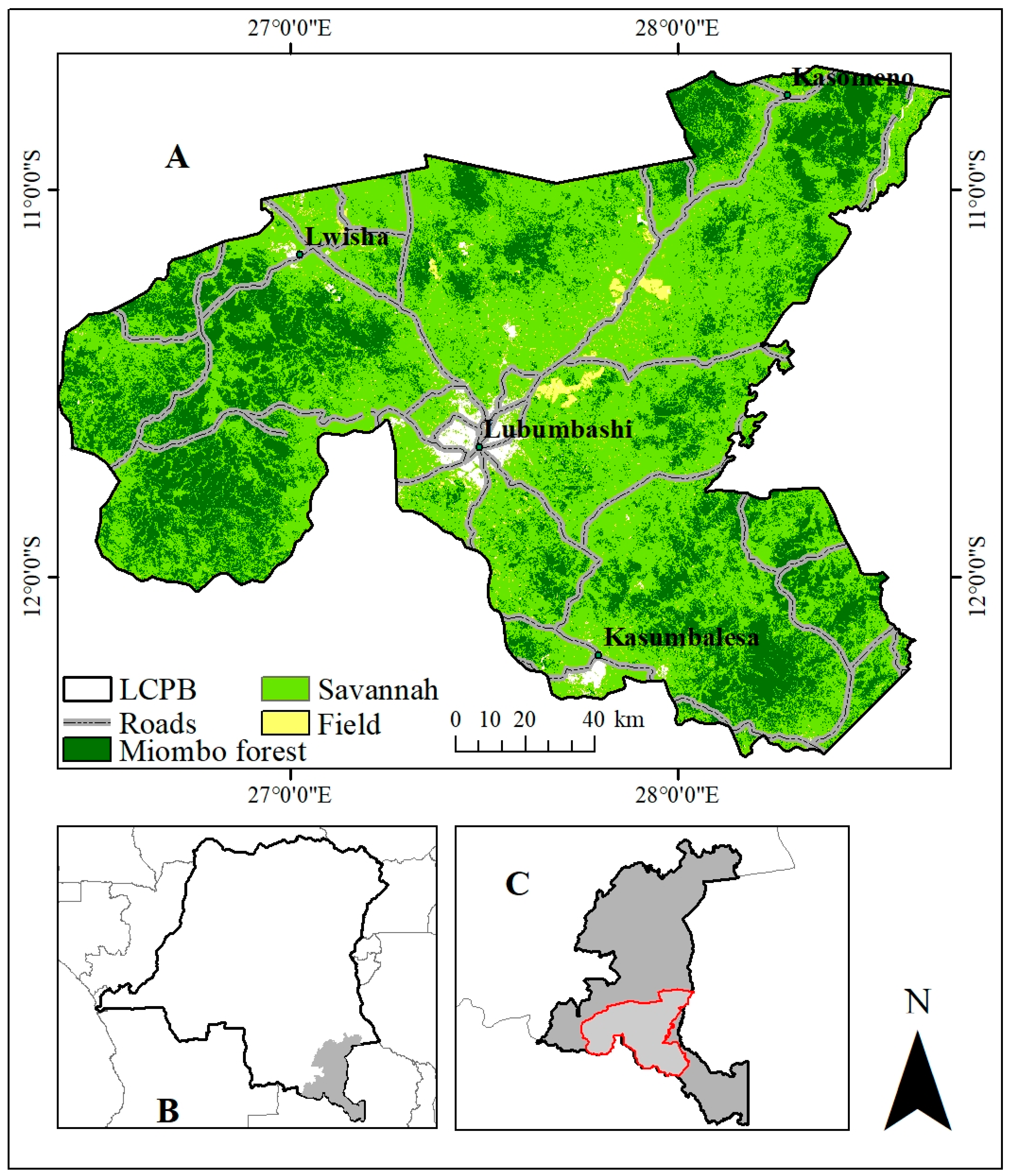
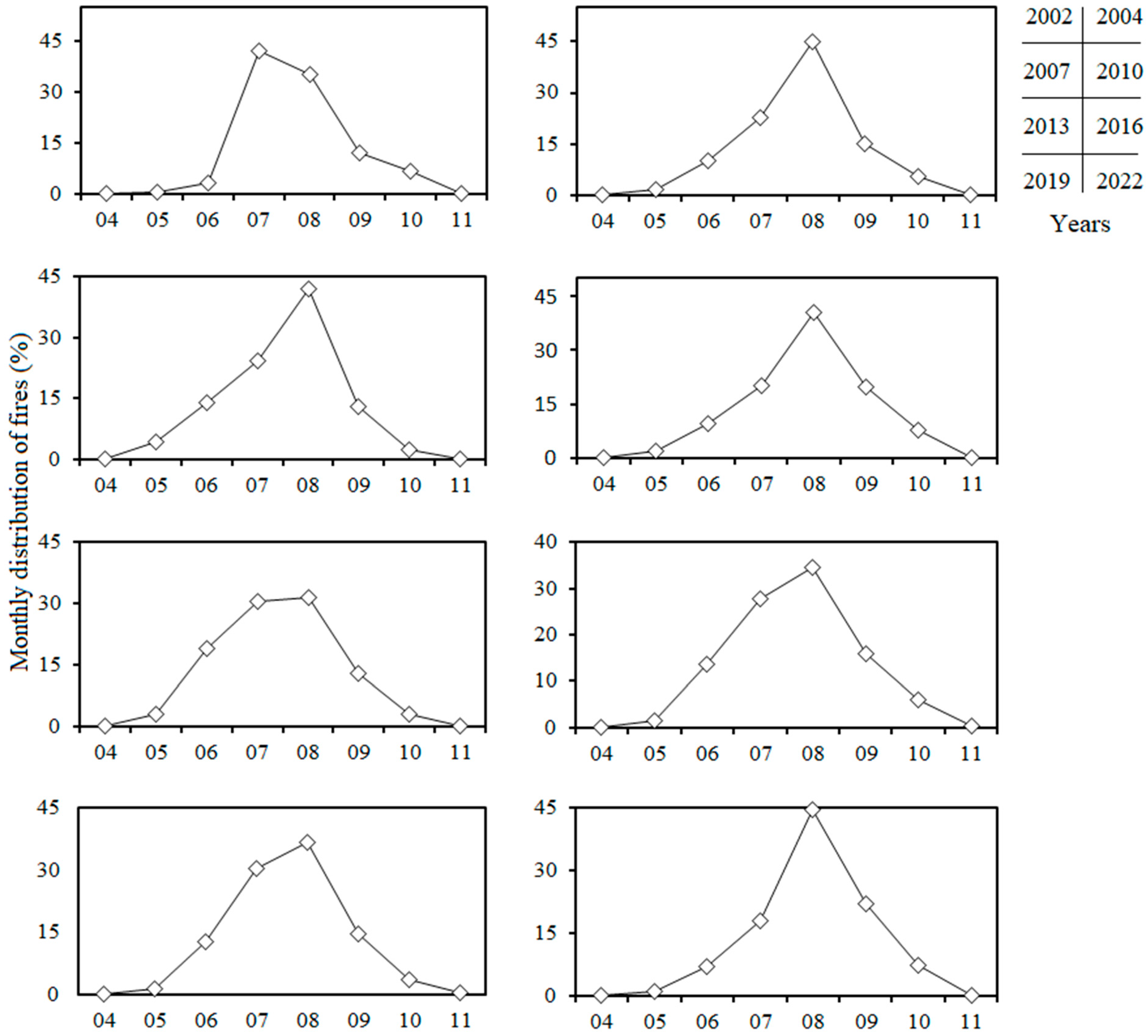
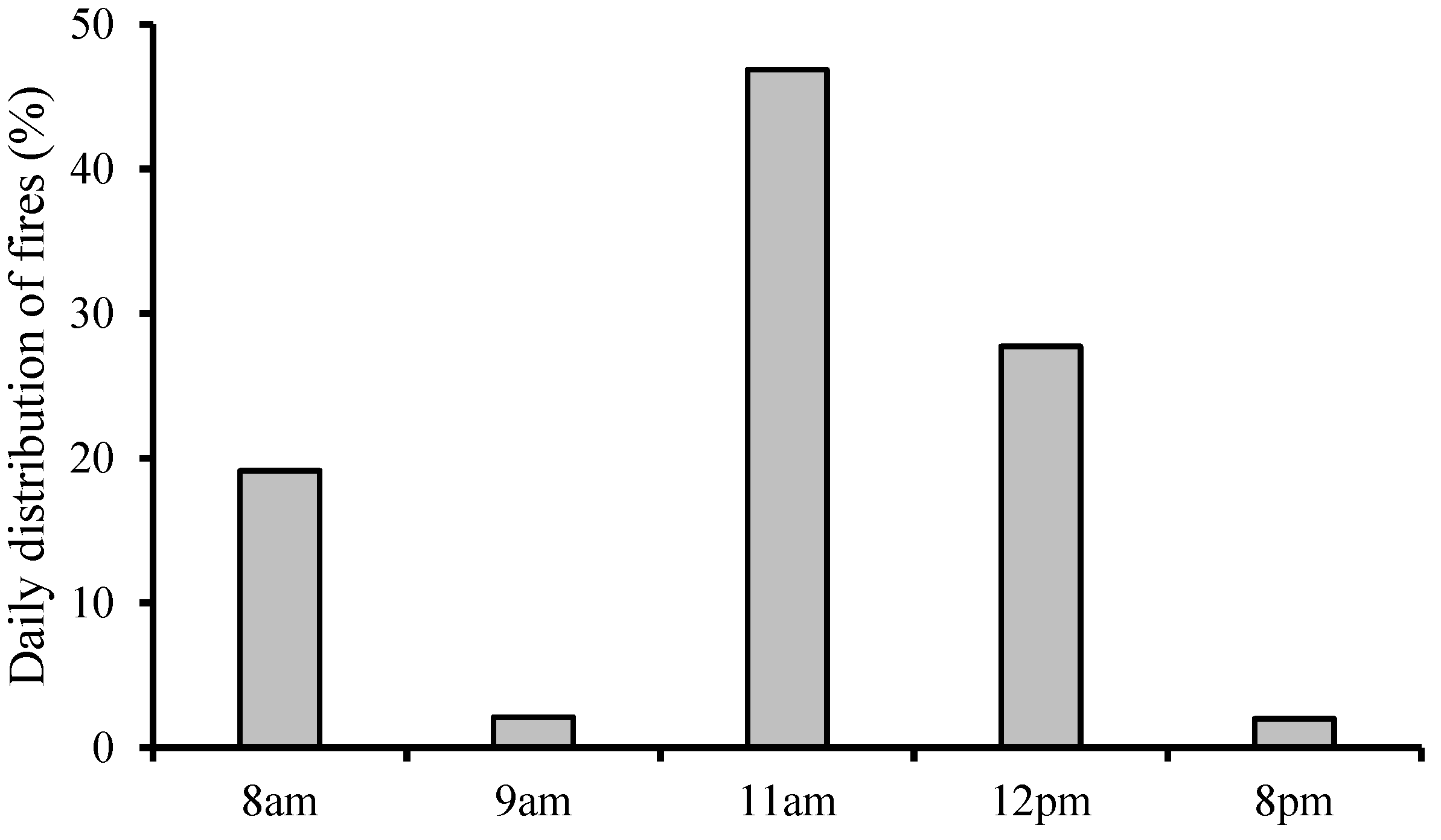
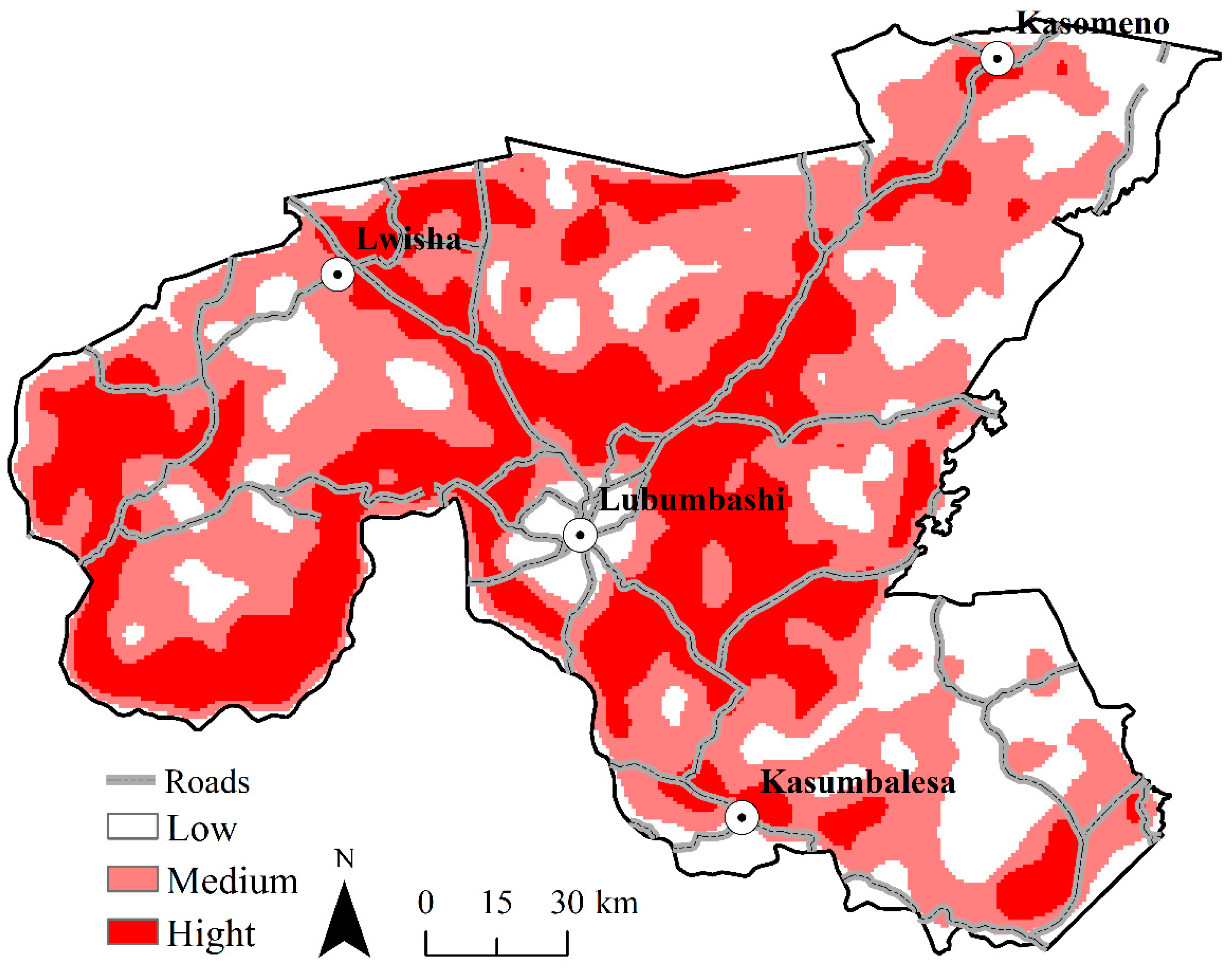
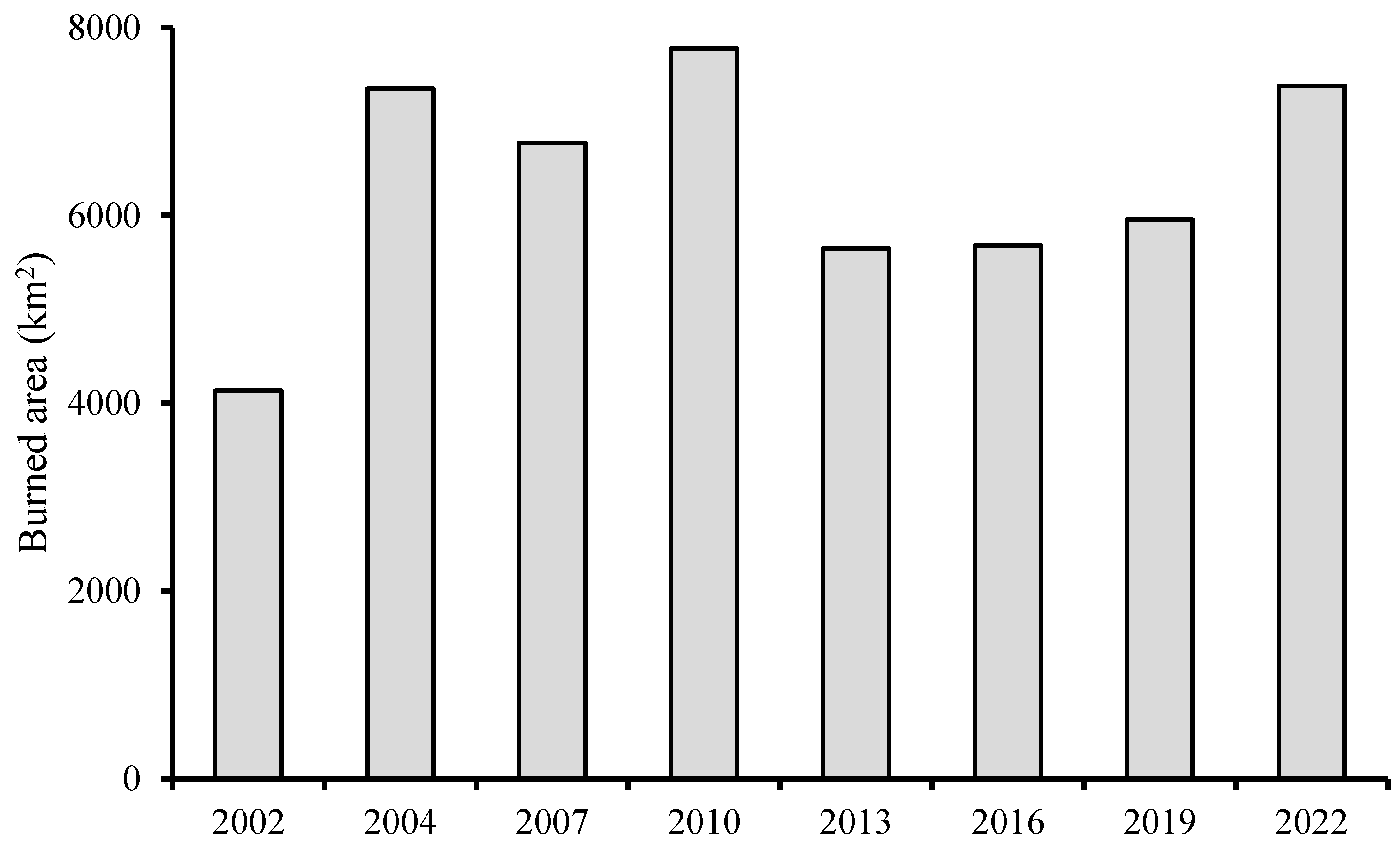
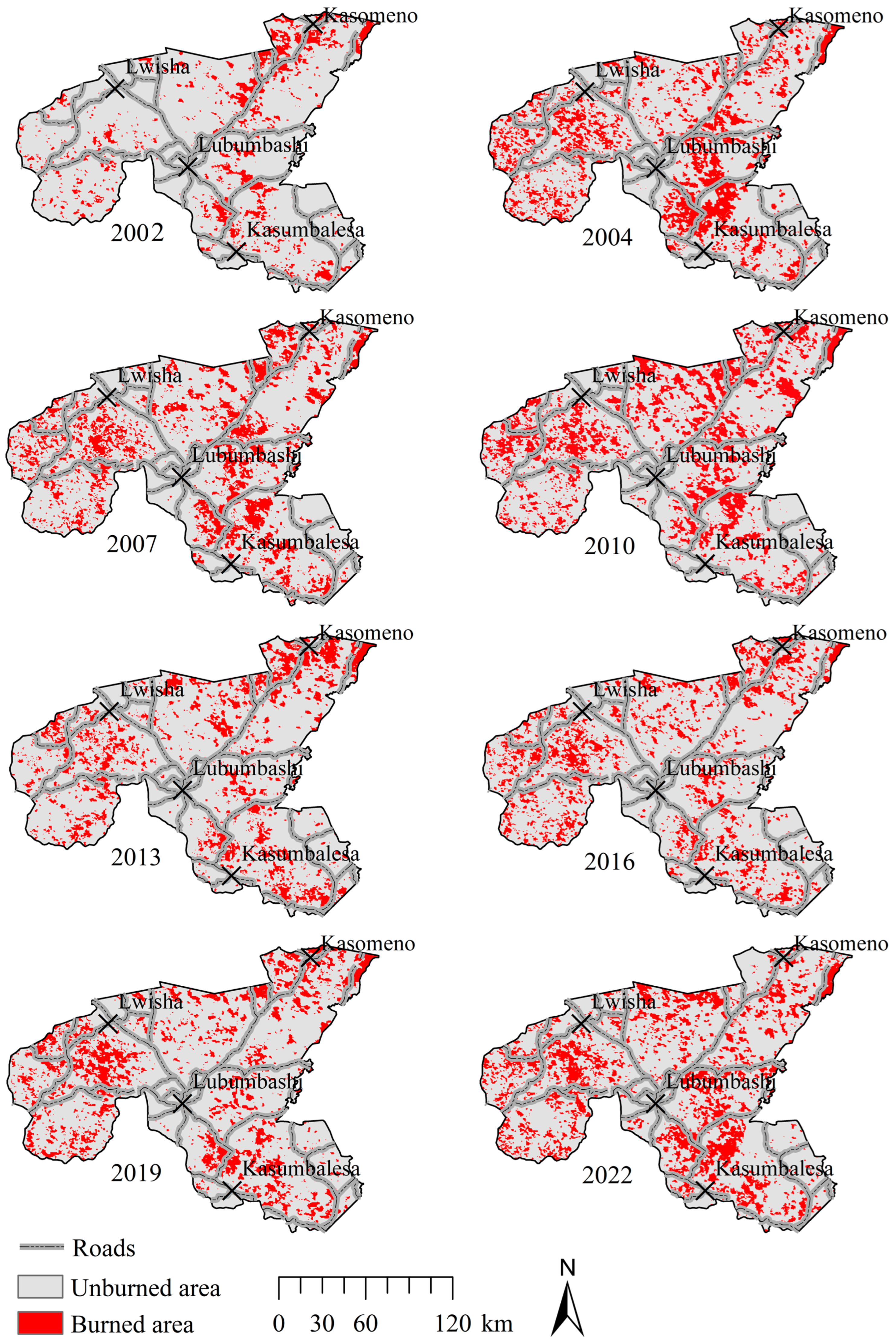
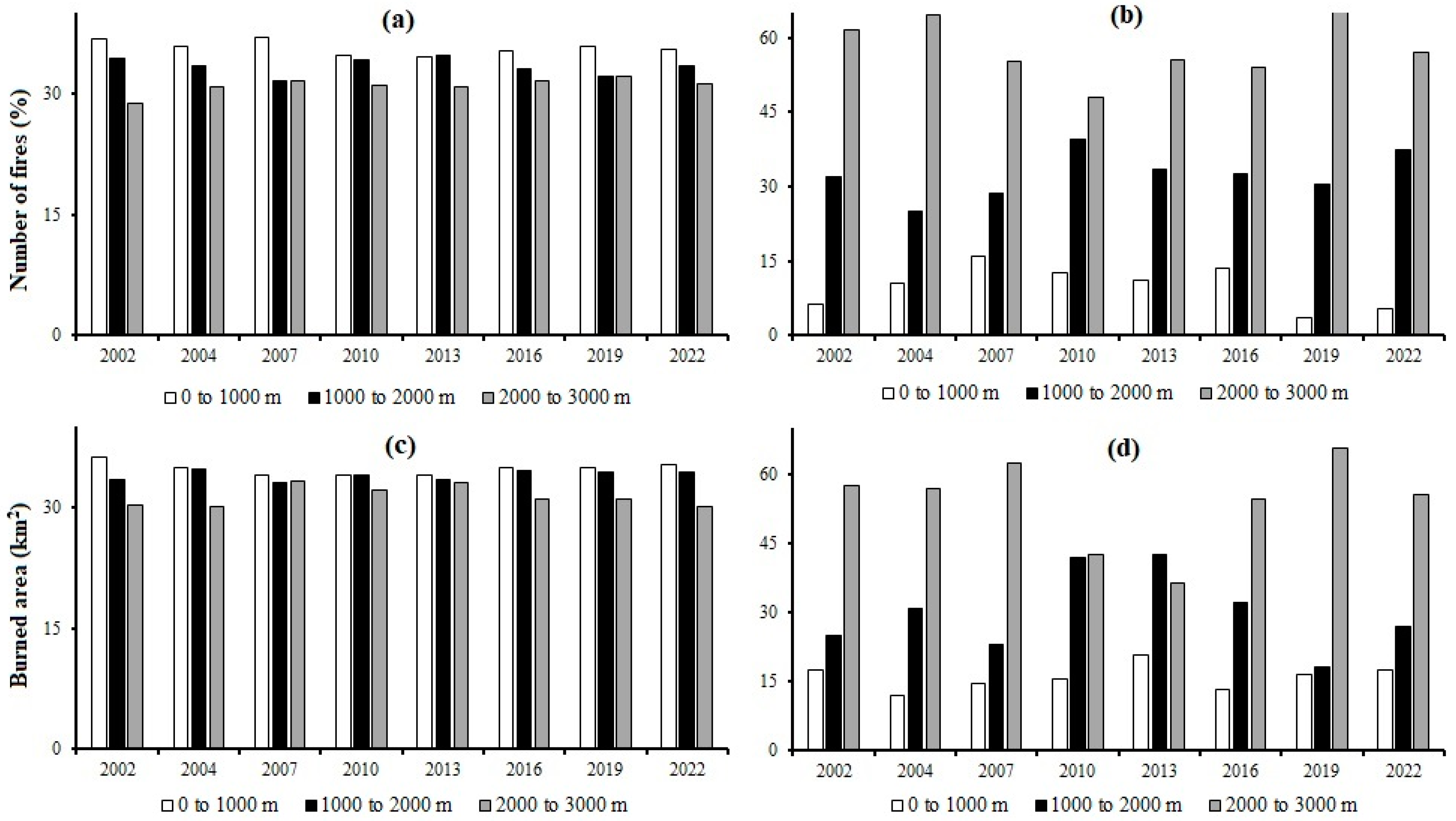
| Land Use Classes | Description | Number of Training Zones (Polygons) |
|---|---|---|
| Forests | Natural land cover: miombo forest, with patches of dense, dry forest and gallery forest | 55 |
| Savannah | Generally anthropogenic land cover: characterized by a low density of trees and a predominance of herbaceous cover. It is more often replaced by bare land in the dry season, after the end of the vegetation period. | 50 |
| Field | This class of anthropogenic land cover is made up of agricultural land after harvesting, abandoned agricultural land, or land occupied by annual and off-season crops. | 45 |
| Other land cover | The bare land/building complex, bodies of water, and unclassified areas | 50 |
| 2002–2004 | FR Stable | SV Stable | FD Stable | BBS Stable | OT Stable | FR Loss | SV Gain | FD Gain | BBS Gain |
|---|---|---|---|---|---|---|---|---|---|
| Accuracy measure | |||||||||
| PA (%) | 96.59 | 91.78 | 100.00 | 96.12 | 99.07 | 100.00 | 100.00 | 98.10 | 94.62 |
| UA (%) | 96.59 | 98.05 | 95.41 | 97.06 | 100.00 | 98.04 | 98.02 | 94.50 | 91.67 |
| Overall accuracy (%) | 96.74 | ||||||||
| Stratified estimators of area ± CI (% of total map area) | |||||||||
| Area (%) | 18.06 | 19.30 | 9.16 | 9.07 | 9.43 | 8.81 | 8.72 | 9.25 | 8.19 |
| 95% CI | 0.64 | 0.80 | 0.38 | 0.45 | 0.17 | 0.24 | 0.24 | 0.48 | 0.61 |
| 2004–2007 | FR Stable | SV Stable | FD Stable | BBS Stable | OT Stable | FR Loss | SV Gain | FD Gain | OT Gain |
| Accuracy measure | |||||||||
| PA (%) | 94.34 | 93.98 | 99.01 | 100.00 | 100.00 | 100.00 | 95.88 | 100.00 | 100.00 |
| UA (%) | 99.01 | 98.54 | 99.01 | 99.03 | 96.08 | 96.30 | 89.42 | 97.98 | 98.25 |
| Overall accuracy (%) | 97.37 | ||||||||
| Stratified estimators of area ± CI (% of total map area) | |||||||||
| Area (%) | 18.23 | 18.14 | 8.76 | 9.12 | 9.29 | 9.20 | 8.94 | 8.67 | 9.65 |
| 95% CI | 0.00 | 0.42 | 0.30 | 0.35 | 0.00 | 0.17 | 0.17 | 0.38 | 0.54 |
| 2007–2010 | FR Stable | SV Stable | FD Stable | BBS Stable | OT Stable | FR Loss | SV Gain | FD Gain | OT Gain |
| Accuracy measure | |||||||||
| PA (%) | 100 | 98.0488 | 100 | 98.0583 | 100 | 99.0385 | 100 | 98.9796 | 93.578 |
| UA (%) | 100 | 99.0148 | 97.0588 | 98.0583 | 100 | 100 | 99.0196 | 96.0396 | 97.1429 |
| Overall accuracy (%) | 98.67 | ||||||||
| Stratified estimators of area ± CI (% of total map area) | |||||||||
| Area (%) | 18.15 | 18.15 | 8.46 | 9.25 | 8.63 | 8.99 | 8.63 | 8.02 | 9.96 |
| 95% CI | 0.45 | 0.46 | 0.47 | 0.30 | 0.34 | 0.00 | 0.38 | 0.24 | 0.34 |
| 2010–2013 | FR Stable | SV Stable | FD Stable | BBS Stable | OT Stable | FR Loss | SV Gain | FD Gain | OT Gain |
| Accuracy measure | |||||||||
| PA (%) | 98.06 | 96.60 | 100.00 | 97.14 | 100.00 | 100.00 | 98.98 | 97.80 | 97.35 |
| UA (%) | 98.54 | 100.00 | 92.31 | 100.00 | 96.08 | 100.00 | 96.04 | 100.00 | 99.10 |
| Overall accuracy (%) | 98.21 | ||||||||
| Stratified estimators of area ± CI (% of total map area) | |||||||||
| Area (%) | 18.32 | 17.96 | 9.30 | 9.21 | 8.66 | 9.21 | 9.21 | 8.94 | 9.21 |
| 95% CI | 0.25 | 0.47 | 0.30 | 0.25 | 0.18 | 0.25 | 0.31 | 0.31 | 0.31 |
| 2013–2016 | FR Stable | SV Stable | FD Stable | BBS Stable | OT Stable | FR Loss | SV Gain | FD Gain | OT Gain |
|---|---|---|---|---|---|---|---|---|---|
| Accuracy measure | |||||||||
| PA (%) | 100.00 | 98.49 | 100.00 | 99.02 | 100.00 | 98.04 | 98.04 | 97.98 | 97.06 |
| UA (%) | 99.02 | 98.00 | 97.17 | 99.02 | 98.97 | 100.00 | 99.01 | 98.98 | 100.00 |
| Overall accuracy (%) | 98.83 | ||||||||
| Stratified estimators of area ± CI (% of total map area) | |||||||||
| Area (%) | 18.32 | 17.96 | 9.30 | 9.21 | 8.66 | 9.21 | 9.21 | 8.94 | 9.21 |
| 95% CI | 0.25 | 0.47 | 0.30 | 0.25 | 0.18 | 0.25 | 0.31 | 0.31 | 0.31 |
| 2016–2019 | FR Stable | SV Stable | FD Stable | BBS Stable | OT Stable | FR Loss | SV Gain | FD Gain | OT Gain |
| Accuracy measure | |||||||||
| PA (%) | 100.00 | 94.42 | 98.99 | 100.00 | 100.00 | 98.11 | 98.10 | 100.00 | 100.00 |
| UA (%) | 99.01 | 100.00 | 98.00 | 97.09 | 98.06 | 99.05 | 99.04 | 98.99 | 95.10 |
| Overall accuracy (%) | 98.48 | ||||||||
| Stratified estimators of area ± CI (% of total map area) | |||||||||
| Area (%) | 17.84 | 19.18 | 8.83 | 8.92 | 9.01 | 9.46 | 9.37 | 8.74 | 8.65 |
| 95% CI | 0.25 | 0.60 | 0.30 | 0.30 | 0.25 | 0.30 | 0.30 | 0.17 | 0.38 |
| 2019–2022 | FR Stable | SV Stable | FD Stable | BBS Stable | OT Stable | FR Loss | SV Gain | FD Gain | OT Gain |
| Accuracy measure | |||||||||
| PA (%) | 100.00 | 99.03 | 100.00 | 98.04 | 100.00 | 100.00 | 100.00 | 100.00 | 98.08 |
| UA (%) | 100.00 | 100.00 | 99.00 | 100.00 | 98.02 | 100.00 | 100.00 | 99.06 | 98.08 |
| Overall accuracy (%) | 99.47 | ||||||||
| Stratified estimators of area ± CI (% of total map area) | |||||||||
| Area (%) | 18.47 | 18.38 | 8.83 | 9.10 | 8.83 | 9.19 | 9.19 | 9.37 | 9.28 |
| 95% CI | 0.00 | 0.25 | 0.17 | 0.25 | 0.25 | 0.00 | 0.00 | 0.17 | 0.35 |
| Radiative Power (%) | |||
|---|---|---|---|
| Low to Very Low | Moderate | Strong | |
| 2002 (n = 7254) | 76 | 15 | 9 |
| 2004 (n = 10,824) | 74 | 17 | 9 |
| 2007 (n = 10,646) | 74 | 17 | 9 |
| 2010 (n = 12,207) | 72 | 18 | 10 |
| 2013 (n = 11,722) | 73 | 18 | 9 |
| 2016 (n = 12,152) | 76 | 16 | 8 |
| 2019 (n = 12,714) | 77 | 16 | 7 |
| 2022 (n = 12,373) | 75 | 17 | 8 |
| Land Cover | Number of Fires by Land Cover | |||||||
| 2002 | 2004 | 2007 | 2010 | 2013 | 2016 | 2019 | 2022 | |
| Forest | 4213 | 5726 | 5482 | 5217 | 4609 | 4350 | 3449 | 3091 |
| Savannah | 3001 | 5043 | 5081 | 6856 | 6917 | 7555 | 8874 | 8994 |
| Field | 15 | 19 | 32 | 32 | 55 | 106 | 107 | 182 |
| Total | 7229 | 10,788 | 10,595 | 12,105 | 11,581 | 12,011 | 12,430 | 12,267 |
| Land Cover | Area burnt by land cover (km2) | |||||||
| 2002 | 2004 | 2007 | 2010 | 2013 | 2016 | 2019 | 2022 | |
| Forest | 2196.59 | 4028.41 | 3621.72 | 3144.00 | 2866.46 | 2606.80 | 2199.42 | 1718.54 |
| Savannah | 1195.07 | 2117.75 | 2008.94 | 3377.28 | 1819.79 | 2234.82 | 2735.77 | 4352.35 |
| Field | 4.71 | 16.05 | 19.59 | 12.84 | 18.12 | 1819.79 | 30.51 | 113.03 |
| Total | 3396.37 | 6162.21 | 5650.25 | 6534.12 | 4704.37 | 6661.41 | 4965.7 | 6183.92 |
Disclaimer/Publisher’s Note: The statements, opinions and data contained in all publications are solely those of the individual author(s) and contributor(s) and not of MDPI and/or the editor(s). MDPI and/or the editor(s) disclaim responsibility for any injury to people or property resulting from any ideas, methods, instructions or products referred to in the content. |
© 2023 by the authors. Licensee MDPI, Basel, Switzerland. This article is an open access article distributed under the terms and conditions of the Creative Commons Attribution (CC BY) license (https://creativecommons.org/licenses/by/4.0/).
Share and Cite
Useni Sikuzani, Y.; Mpanda Mukenza, M.; Khoji Muteya, H.; Cirezi Cizungu, N.; Malaisse, F.; Bogaert, J. Vegetation Fires in the Lubumbashi Charcoal Production Basin (The Democratic Republic of the Congo): Drivers, Extent and Spatiotemporal Dynamics. Land 2023, 12, 2171. https://doi.org/10.3390/land12122171
Useni Sikuzani Y, Mpanda Mukenza M, Khoji Muteya H, Cirezi Cizungu N, Malaisse F, Bogaert J. Vegetation Fires in the Lubumbashi Charcoal Production Basin (The Democratic Republic of the Congo): Drivers, Extent and Spatiotemporal Dynamics. Land. 2023; 12(12):2171. https://doi.org/10.3390/land12122171
Chicago/Turabian StyleUseni Sikuzani, Yannick, Médard Mpanda Mukenza, Héritier Khoji Muteya, Nadège Cirezi Cizungu, François Malaisse, and Jan Bogaert. 2023. "Vegetation Fires in the Lubumbashi Charcoal Production Basin (The Democratic Republic of the Congo): Drivers, Extent and Spatiotemporal Dynamics" Land 12, no. 12: 2171. https://doi.org/10.3390/land12122171
APA StyleUseni Sikuzani, Y., Mpanda Mukenza, M., Khoji Muteya, H., Cirezi Cizungu, N., Malaisse, F., & Bogaert, J. (2023). Vegetation Fires in the Lubumbashi Charcoal Production Basin (The Democratic Republic of the Congo): Drivers, Extent and Spatiotemporal Dynamics. Land, 12(12), 2171. https://doi.org/10.3390/land12122171





